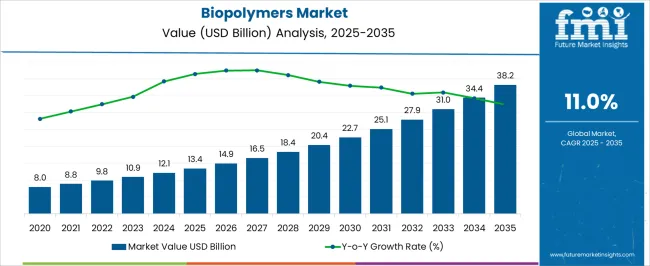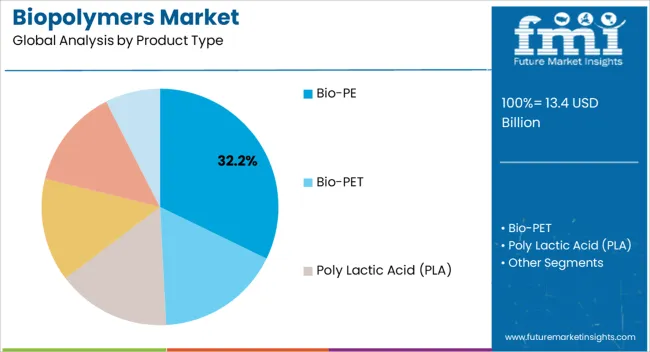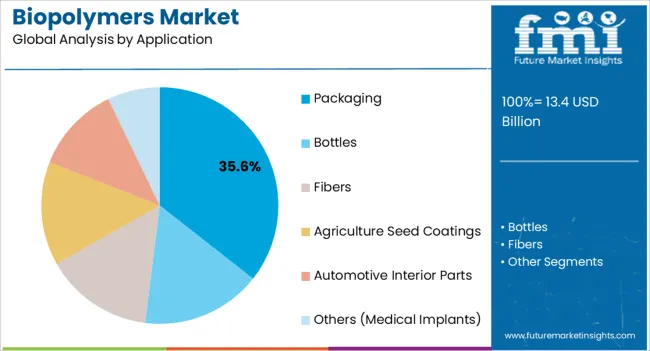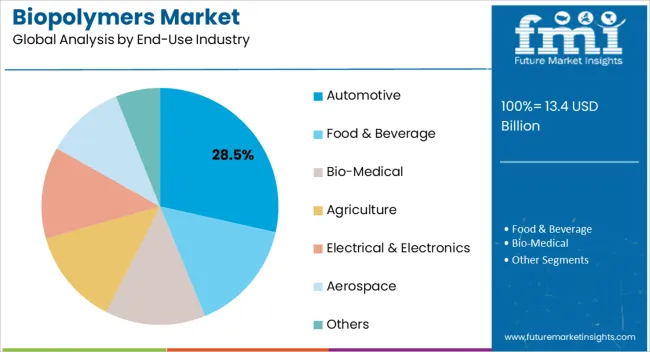The Biopolymers Market is estimated to be valued at USD 13.4 billion in 2025 and is projected to reach USD 38.2 billion by 2035, registering a compound annual growth rate (CAGR) of 11.0% over the forecast period.

| Metric | Value |
|---|---|
| Biopolymers Market Estimated Value in (2025 E) | USD 13.4 billion |
| Biopolymers Market Forecast Value in (2035 F) | USD 38.2 billion |
| Forecast CAGR (2025 to 2035) | 11.0% |
The Biopolymers market is experiencing strong growth, driven by increasing environmental awareness, regulatory pressure to reduce plastic waste, and the global push for sustainable materials. Adoption is being supported by technological advancements in polymer synthesis, biodegradability, and performance properties that enable substitution of conventional plastics in diverse applications. Demand is further reinforced by consumer preference for eco-friendly products and corporate sustainability initiatives across industries.
The market is shaped by the integration of biopolymers into packaging, automotive components, consumer goods, and healthcare products, where performance and environmental compliance are both critical. Cost reductions achieved through process optimization and scaling of production capacities are increasing commercial viability. Additionally, partnerships between biopolymer manufacturers and end-use industries are accelerating product development tailored to specific application requirements.
With rising investments in research and development, regulatory incentives, and growing adoption of circular economy principles, the Biopolymers market is poised for sustained expansion Continuous innovation in material performance, process efficiency, and eco-design is expected to create new growth opportunities over the coming decade.
The biopolymers market is segmented by product type, application, end-use industry, and geographic regions. By product type, biopolymers market is divided into Bio-PE, Bio-PET, Poly Lactic Acid (PLA), Polyhydroxyalkanoate (PHA), Biodegradable Polyesters, and Others (Biodegradable Starch Blends, Biodegradable Polyesters etc.). In terms of application, biopolymers market is classified into Packaging, Bottles, Fibers, Agriculture Seed Coatings, Automotive Interior Parts, and Others (Medical Implants). Based on end-use industry, biopolymers market is segmented into Automotive, Food & Beverage, Bio-Medical, Agriculture, Electrical & Electronics, Aerospace, and Others. Regionally, the biopolymers industry is classified into North America, Latin America, Western Europe, Eastern Europe, Balkan & Baltic Countries, Russia & Belarus, Central Asia, East Asia, South Asia & Pacific, and the Middle East & Africa.

The bio-PE product type segment is projected to hold 32.2% of the Biopolymers market revenue in 2025, making it the leading product type. Growth in this segment is being driven by its chemical and physical similarity to conventional polyethylene, which enables easy integration into existing manufacturing processes without extensive equipment modification. Bio-PE offers benefits such as renewability, lower carbon footprint, and compatibility with recycling systems, which support adoption across multiple applications.
Increasing demand from packaging, consumer goods, and automotive sectors has reinforced its market position. Technological advancements in feedstock utilization and polymerization processes have improved performance consistency and reduced production costs, making it a commercially attractive option.
The scalability of bio-PE production, combined with regulatory support for renewable and low-emission materials, is further contributing to growth As industries continue to adopt sustainable materials to meet environmental targets and consumer expectations, bio-PE is expected to maintain its leadership in the market, supported by ongoing innovations in material performance and process efficiency.

The packaging application segment is anticipated to account for 35.6% of the market revenue in 2025, establishing it as the leading application area. Growth in this segment is being driven by the increasing global emphasis on sustainable and eco-friendly packaging solutions to reduce plastic waste and comply with environmental regulations. Biopolymers are being adopted for flexible films, rigid containers, and biodegradable packaging products that meet functional and environmental requirements.
Integration of bio-based materials into supply chains enables manufacturers to meet corporate sustainability goals while addressing consumer demand for environmentally responsible packaging. Technological advancements in biopolymer processing, barrier properties, and mechanical strength have enhanced suitability for packaging applications.
The ability to customize biopolymer formulations to achieve desired properties without compromising biodegradability or recyclability is reinforcing adoption As regulatory pressure intensifies and corporate responsibility initiatives grow, packaging is expected to remain the primary application driving Biopolymers market growth, supported by continuous innovation in material performance and cost-effective production.

The automotive end-use industry segment is projected to hold 28.5% of the Biopolymers market revenue in 2025, positioning it as the leading end-use industry. Growth is being driven by the increasing adoption of lightweight, renewable, and recyclable materials to improve fuel efficiency, reduce emissions, and meet environmental regulations. Biopolymers are being leveraged for interior components, panels, and under-the-hood applications where durability, performance, and sustainability are essential.
Integration of biopolymers supports automakers in achieving carbon reduction targets and enhances brand positioning through eco-friendly initiatives. Technological innovations in thermal stability, mechanical performance, and process compatibility have enabled broader adoption in automotive manufacturing.
Collaborations between biopolymer producers and automotive OEMs have facilitated the development of application-specific materials, reducing implementation barriers As the automotive sector increasingly prioritizes sustainability and regulatory compliance, biopolymers are expected to maintain their leadership, supported by continued investment in R&D, performance optimization, and cost-effective production methods that meet industry standards.
According to the latest market survey conducted by Future Market Insights, the global Biopolymers market is relishing a market valuation of US$ 12.09 Bn in 2025 and is all set to expand with a CAGR of 11.03% during the 2025 – 2035 period. The market is anticipated to top a valuation of US$ 34.42 Bn by the end of the forecast period.
| Market Size 2025 | US$ 12.09 Bn |
| Market Size 2035 | US$ 34.42 Bn |
| Value CAGR (2025-2035) | 11.03% |
| Collective Value Share: Top 3 Countries (2025E) | 45% – 55% |
Biopolymers are synthetic materials made from plant-based sources such as sugar cane, corn, and other agricultural products as well as residual wood and standing lumber. Unlike conventional polymers or plastics, which contribute to a number of environmental problems like pollution and global warming, biopolymers are naturally biodegradable, making them useful in a variety of applications, including, emulsions, edible films, packaging materials in the food industry, as well as drug transport materials, dressing materials, and medical implants in pharmaceutical industries.
The manufacturing of polymers from renewable resources is expected to be one of the fastest-growing material industries during the past several years. These polymers have the potential to displace polymers derived from fossil fuels, which is what is driving their research. The primary causes of this drive can be summed up as follows: insufficient fossil fuel resources; unstable fossil fuel prices; the role of fossil fuel as a feedstock in climate change; its sporadic use as a political weapon; and its connection to the waste disposal issue brought on by polymers made from fossil fuels.

| Country | CAGR |
|---|---|
| China | 14.9% |
| India | 13.8% |
| Germany | 12.7% |
| France | 11.6% |
| UK | 10.5% |
| USA | 9.4% |
| Brazil | 8.3% |
The Biopolymers Market is expected to register a CAGR of 11.0% during the forecast period, exhibiting varied country level momentum. China leads with the highest CAGR of 14.9%, followed by India at 13.8%. Developed markets such as Germany, France, and the UK continue to expand steadily, while the USA is likely to grow at consistent rates. Brazil posts the lowest CAGR at 8.3%, yet still underscores a broadly positive trajectory for the global Biopolymers Market. In 2024, Germany held a dominant revenue in the Western Europe market and is expected to grow with a CAGR of 12.7%. The USA Biopolymers Market is estimated to be valued at USD 4.6 billion in 2025 and is anticipated to reach a valuation of USD 11.2 billion by 2035. Sales are projected to rise at a CAGR of 9.4% over the forecast period between 2025 and 2035. While Japan and South Korea markets are estimated to be valued at USD 696.0 million and USD 406.3 million respectively in 2025.

| Item | Value |
|---|---|
| Quantitative Units | USD 13.4 Billion |
| Product Type | Bio-PE, Bio-PET, Poly Lactic Acid (PLA), Polyhydroxyalkanoate (PHA), Biodegradable Polyesters, and Others (Biodegradable Starch Blends, Biodegradable Polyesters etc.) |
| Application | Packaging, Bottles, Fibers, Agriculture Seed Coatings, Automotive Interior Parts, and Others (Medical Implants) |
| End-Use Industry | Automotive, Food & Beverage, Bio-Medical, Agriculture, Electrical & Electronics, Aerospace, and Others |
| Regions Covered | North America, Europe, Asia-Pacific, Latin America, Middle East & Africa |
| Country Covered | United States, Canada, Germany, France, United Kingdom, China, Japan, India, Brazil, South Africa |
| Key Companies Profiled | BASF SE, Braskem S.A., Arkema, Meredian Holdings Group Inc., NatureWorks LLC, Corbion NV, Metabolix, Inc., Danimer Scientific, Biopolymer International, Solanyl Biopolymers, HARBEC, Inc., Metabolix Inc., and Novamont S.p.A. |
The global biopolymers market is estimated to be valued at USD 13.4 billion in 2025.
The market size for the biopolymers market is projected to reach USD 38.2 billion by 2035.
The biopolymers market is expected to grow at a 11.0% CAGR between 2025 and 2035.
The key product types in biopolymers market are bio-pe, bio-pet, poly lactic acid (pla), polyhydroxyalkanoate (pha), biodegradable polyesters and others (biodegradable starch blends, biodegradable polyesters etc.).
In terms of application, packaging segment to command 35.6% share in the biopolymers market in 2025.






Our Research Products

The "Full Research Suite" delivers actionable market intel, deep dives on markets or technologies, so clients act faster, cut risk, and unlock growth.

The Leaderboard benchmarks and ranks top vendors, classifying them as Established Leaders, Leading Challengers, or Disruptors & Challengers.

Locates where complements amplify value and substitutes erode it, forecasting net impact by horizon

We deliver granular, decision-grade intel: market sizing, 5-year forecasts, pricing, adoption, usage, revenue, and operational KPIs—plus competitor tracking, regulation, and value chains—across 60 countries broadly.

Spot the shifts before they hit your P&L. We track inflection points, adoption curves, pricing moves, and ecosystem plays to show where demand is heading, why it is changing, and what to do next across high-growth markets and disruptive tech

Real-time reads of user behavior. We track shifting priorities, perceptions of today’s and next-gen services, and provider experience, then pace how fast tech moves from trial to adoption, blending buyer, consumer, and channel inputs with social signals (#WhySwitch, #UX).

Partner with our analyst team to build a custom report designed around your business priorities. From analysing market trends to assessing competitors or crafting bespoke datasets, we tailor insights to your needs.
Supplier Intelligence
Discovery & Profiling
Capacity & Footprint
Performance & Risk
Compliance & Governance
Commercial Readiness
Who Supplies Whom
Scorecards & Shortlists
Playbooks & Docs
Category Intelligence
Definition & Scope
Demand & Use Cases
Cost Drivers
Market Structure
Supply Chain Map
Trade & Policy
Operating Norms
Deliverables
Buyer Intelligence
Account Basics
Spend & Scope
Procurement Model
Vendor Requirements
Terms & Policies
Entry Strategy
Pain Points & Triggers
Outputs
Pricing Analysis
Benchmarks
Trends
Should-Cost
Indexation
Landed Cost
Commercial Terms
Deliverables
Brand Analysis
Positioning & Value Prop
Share & Presence
Customer Evidence
Go-to-Market
Digital & Reputation
Compliance & Trust
KPIs & Gaps
Outputs
Full Research Suite comprises of:
Market outlook & trends analysis
Interviews & case studies
Strategic recommendations
Vendor profiles & capabilities analysis
5-year forecasts
8 regions and 60+ country-level data splits
Market segment data splits
12 months of continuous data updates
DELIVERED AS:
PDF EXCEL ONLINE

Thank you!
You will receive an email from our Business Development Manager. Please be sure to check your SPAM/JUNK folder too.
Chat With
MaRIA